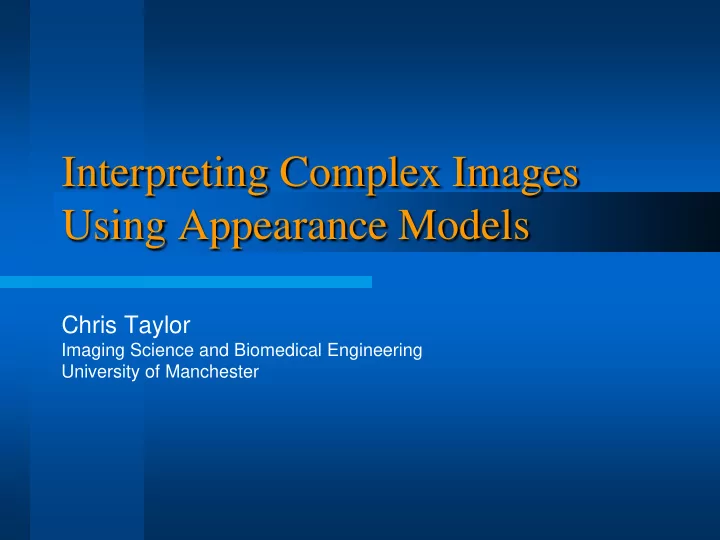

Interpreting Complex Images Using Appearance Models Chris Taylor Imaging Science and Biomedical Engineering University of Manchester
Acknowlegments Tim Cootes Gareth Edwards Christine Beeston Rhodri Davies (IPMI 2003 and PhD Thesis)
Overview Problem definition / motivation Modelling shape Modelling appearance Interpreting images using appearance models Practical applications
Problem Definition / Motivation
Complex and Variable Objects Faces Medical images Manufactured assemblies
Understanding Images Relating image to a conceptual model – high-level interpretation ‘Explaining’ the image – class of valid interpretations Labelling structures – basis for analysis
What Makes a Good Approach? Principled – makes assumptions explicit – uses domain knowledge systematically Generic – can be applied directly to new problems Computationally tractable – practical using standard PC/workstation
Interpretation by Synthesis Interpret images using generative models of appearance – ‘explain’ the image Labels Model Parameters Fit Model
Generative Models High-level description – shape – spatial relationships – grey-level appearance (texture map) Compact Parameterised
Modelling Issues General – deformable to represent any example of class Specific – only represent ‘legal’ examples of class Learn from examples – knowledge of how things vary – generic
Modelling Shape
Modelling From: PhD thesis Rhodri Davies
Modelling From: PhD thesis Rhodri Davies
Modelling Shape Define each example using points Each (aligned) example is a vector x i = { x i1 , y i1 , x i2 , y i2 …x in , y in } 6 5 4 3 2 1
Statistical Shape Models 4 3 2 1 n x 1 = ( x 1 , y 1 , …, x n , y n ) T x ns-1 = ( x 1 , y 1 , …, x n , y n ) T x ns = ( x 1 , y 1 , …, x n , y n ) T Shape vector – statistical analysis – correspondence problem
Modelling Shape Points tend to move in correlated ways x 2 b 1 x x i x 1
Statistics of Shape Variability
Statistics of Shape Variability
Statistics of Shape Variability
Statistics of Shape Variability
Statistics of Shape Variability 90% variability explained by 7 eigenmodes Cumulative function of Eigenvalues (example with eigenvalues, normalized 22 shapes)
Statistics of Shape Variability Each shape x with dimensionality 2n can be expressed with a b-vector with dimensionality t, t << 2n)
Modelling Shape Principal component analysis (PCA) = + x x Pb = P modes of variation = b shape vector Reduced dimensionality – typically 10 - 50 shape parameters
Statistical Shape Models Principal components analysis (PCA) Generative shape model: = + x : mean shape x x Pb i i P : modes of variation b i : shape parameters Reduced dimensionality – typically 10 - 50 shape parameters
Hand Model Modes of shape variation b b b 1 2
Hand Model: Eigenmodes of Variation From: PhD thesis Rhodri Davies
Importance of Correspondence From: PhD thesis Rhodri Davies Left: Arc-length parametrization Right: Manual placement of corresponding landmarks
Correspondence and quality of shape model From: PhD thesis Rhodri Davies Left: Manual placement, Right: Arc-length parametrization
Face Model Shape and spatial relationships b b b 1 2
Recommend
More recommend